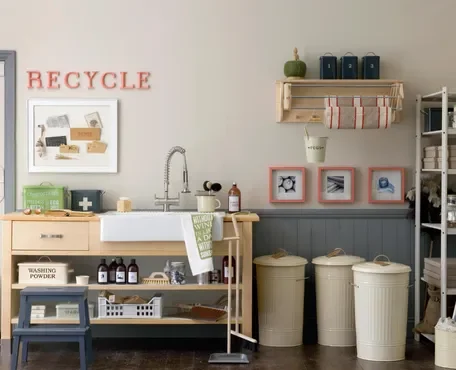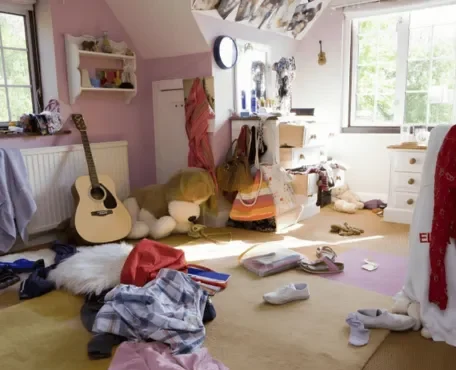
In a world bombarded with constant stimuli and possessions, clutter can easily accumulate and overwhelm us. From physical items cluttering our living spaces to digital clutter crowding our devices, the accumulation of unnecessary things can lead to stress, anxiety, and a feeling of being weighed down. However, the journey to decluttering isn’t just about tidying up physical spaces; it’s also about simplifying our lives, fostering mental clarity, and prioritizing what truly matters.
Strategies and techniques to help you effectively reduce clutter and embrace a simpler.

1*.Understanding Clutter:
Before diving into decluttering strategies, it’s crucial to understand what clutter is and how it affects us. Clutter isn’t just about having too many things; it’s also about disorganization and the inability to manage our belongings efficiently. Clutter can manifest in various forms, including physical clutter (excess belongings), digital clutter (unorganized files and emails), mental clutter (overwhelmed thoughts and emotions), and even spiritual clutter (distractions from our values and goals). Recognizing the different types of clutter in our lives is the first step towards effectively tackling them.
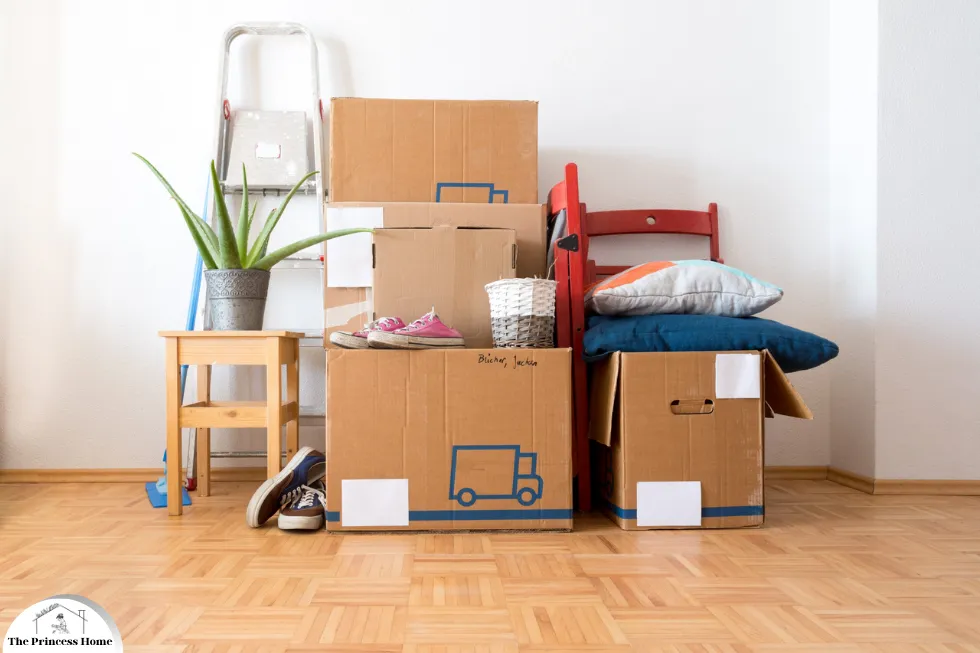
2*.The Benefits of Decluttering:
The process of decluttering goes beyond simply creating a tidier environment. It offers a myriad of benefits that can significantly improve our quality of life:
1.Reduced Stress and Anxiety:
Studies have shown that cluttered environments can contribute to elevated stress levels and decreased mental well-being. By decluttering our surroundings, we create a sense of order and calm, promoting relaxation and peace of mind.
2.Increased Productivity:
Clutter can be a major distraction, hindering our ability to focus and concentrate on tasks. Clearing out unnecessary items and organizing our spaces can boost productivity by eliminating distractions and creating a conducive environment for work and creativity.
3.Enhanced Mental Clarity:
A clutter-free environment fosters mental clarity and allows us to think more clearly. When our physical and digital spaces are organized, our minds feel less cluttered, enabling us to make better decisions and solve problems more effectively.
4.Improved Health and Well-being:
Cluttered spaces are breeding grounds for dust, allergens, and germs, which can negatively impact our health. By decluttering and regularly cleaning our living spaces, we create a healthier environment for ourselves and our families, reducing the risk of allergies and respiratory issues.
5.Financial Savings:
Clutter often leads to overspending and wasteful consumption. By decluttering and becoming more mindful of our purchasing habits, we can save money, reduce waste, and live more sustainably.
Strategies for Decluttering: Simplify Your Life, Clear Your Space
In a world inundated with possessions, commitments, and distractions, the art of decluttering has become a vital skill for maintaining mental clarity, improving productivity, and fostering a sense of calm in our daily lives. Whether it’s physical clutter in our homes or digital clutter in our devices, the accumulation of unnecessary items and information can weigh heavily on our minds and hinder our ability to focus on what truly matters. Fortunately, there are numerous strategies and techniques that can help individuals reclaim control over their surroundings and streamline their environments for greater efficiency and peace of mind.
1. Start Small, Think Big
The prospect of decluttering an entire home or workspace can be overwhelming, leading many to procrastinate or abandon the task altogether. Instead of tackling everything at once, start with small, manageable areas such as a single drawer, shelf, or closet. Breaking the process down into smaller tasks makes it more manageable and allows for incremental progress over time. As you experience success in these smaller areas, you’ll gain momentum and confidence to take on larger projects.
2. Adopt the KonMari Method
Made famous by organizing consultant Marie Kondo, the KonMari Method emphasizes the importance of decluttering by category rather than by location. Kondo’s approach involves gathering all items within a particular category (e.g., clothing, books, sentimental items) and evaluating each one individually to determine if it sparks joy. By focusing on the emotional connection to each item, rather than arbitrary criteria like utility or cost, individuals can make more mindful decisions about what to keep and what to discard.
3. Embrace Minimalism
Minimalism is a lifestyle philosophy centered around the idea of living with less and prioritizing the things that bring genuine value and joy. Adopting a minimalist mindset involves decluttering not only physical possessions but also digital distractions, commitments, and obligations that do not align with your priorities and values. By simplifying your life and eliminating excess, you create space for what truly matters, whether it’s pursuing your passions, spending time with loved ones, or pursuing personal growth.
4. Practice Mindful Consumption
In a consumer-driven society, we’re constantly bombarded with messages encouraging us to buy more, upgrade our possessions, and keep up with the latest trends. However, mindful consumption involves questioning the impulse to accumulate more and instead focusing on mindful purchasing decisions. Before making a purchase, ask yourself if the item aligns with your values, serves a genuine need, and brings long-term satisfaction. By cultivating a more intentional approach to consumption, you can reduce clutter and minimize waste while promoting sustainability and mindful living.
5. Seek Support &Accountability
Decluttering can be a challenging and emotional process, especially when it involves parting with sentimental items or confronting deeply ingrained habits. Seek support from friends, family members, or professional organizers who can provide encouragement, guidance, and accountability throughout your decluttering journey. Consider enlisting the help of a decluttering buddy or joining online communities dedicated to minimalist living and decluttering for additional motivation and support.
Keeping a clean and organized space is not just about aesthetics; it’s about creating an environment that fosters productivity, reduces stress, and promotes overall well-being. Whether you’re tackling a cluttered home, a messy office, or even just a disorganized corner,
20 Tips: Your Guide to a Clean and Organized Space

1.Start with a Plan:
Before diving into cleaning, take a moment to assess the space and create a plan of action. Identify problem areas, prioritize tasks, and set realistic goals for what you hope to accomplish. Absolutely, starting with a plan is crucial for effective cleaning.
Here’s a step-by-step guide to get you started:
1.Assess the Space: Walk through the area you want to clean and take note of problem areas such as cluttered surfaces, dirty floors, or areas that require special attention.
2.Identify Priorities: Determine which tasks are most important to tackle first. For example, if you’re cleaning a kitchen, you might prioritize cleaning the countertops and sink before moving on to other areas.
3.Set Realistic Goals: Be realistic about what you can accomplish in the time you have available. Break down larger tasks into smaller, more manageable ones to prevent overwhelm.
4.Gather Supplies: Make sure you have all the necessary cleaning supplies and equipment before you begin. This might include cleaners, sponges, rags, a vacuum cleaner, and trash bags.
5.Create a Cleaning Schedule: Decide how you want to divide your time and allocate specific tasks to each time block. This will help you stay focused and ensure you make progress efficiently.
6.Start Cleaning: Once you have a plan in place, start working through your tasks systematically. Focus on one area at a time, and don’t move on to the next until you’ve completed the current task.
7.Stay Flexible: Be prepared to adapt your plan as needed. You may encounter unexpected challenges or distractions along the way, so it’s important to remain flexible and adjust your approach as necessary.
By taking the time to create a plan before you start cleaning, you’ll set yourself up for success and make the process more efficient and manageable.
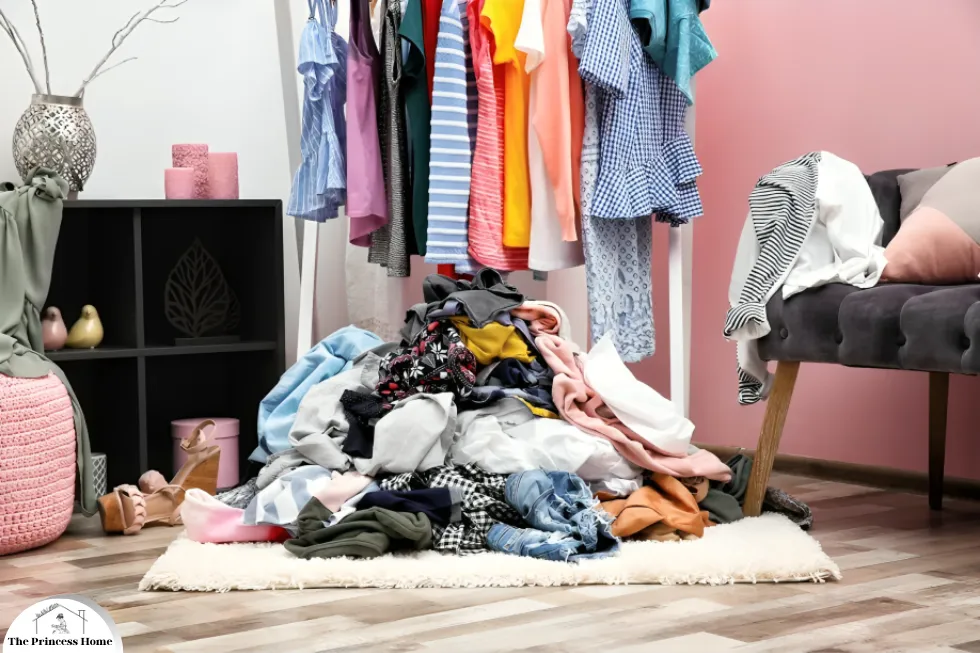
2.Declutter Regularly:
Clutter is the enemy of a clean space. Make decluttering a regular habit by sorting through your belongings regularly and getting rid of items you no longer need or use. Decluttering regularly is key to maintaining a clean and organized space.
Here’s how you can incorporate it into your routine:
1.Set a Schedule: Designate specific times throughout the week or month to declutter different areas of your home. For example, you might declutter a different room each weekend or spend 15 minutes each evening decluttering a small area.
2.Start Small: Tackling an entire room can feel overwhelming, so start with small, manageable tasks. Focus on decluttering one drawer, shelf, or surface at a time.
3.Sort Items: As you declutter, sort items into categories such as keep, donate, recycle, or trash. Be honest with yourself about whether you truly need or use each item.
4.Stay Consistent: Make decluttering a regular habit to prevent clutter from accumulating again. Set reminders on your calendar or integrate it into your weekly cleaning routine.
5.Create Storage Solutions: Invest in storage solutions such as bins, baskets, or shelving to help keep your belongings organized. Labeling containers can also make it easier to find what you need.
6.Donate or Dispose of Items: Once you’ve sorted through your belongings, take action to donate or dispose of items you no longer need. This will free up space in your home and prevent clutter from building up.
7.Prevent Future Clutter: Be mindful of what you bring into your home and avoid unnecessary purchases. Before buying something new, consider whether you have a genuine need for it and whether you have space to store it.
By making decluttering a regular part of your routine, you’ll not only keep your space clean and organized but also create a more peaceful and functional environment to live in.

3.Adopt the One-In-One-Out Rule:
To prevent clutter from re-accumulating after decluttering, implement the one in, one out rule. For every new item you bring into your home or workspace, commit to removing an equivalent item. This simple yet effective strategy helps maintain equilibrium and prevents possessions from spiraling out of control. Before acquiring something new, consider whether it truly adds value to your life and if you’re willing to part with something else to make room for it.
Here’s how you can implement it effectively:
1.Define Your Space: Determine which areas of your home or life you want to apply the one-in-one-out rule to. This could include your wardrobe, kitchen, office supplies, or any other space where clutter tends to accumulate.
2.Commitment to Balance: Make a conscious commitment that for every new item you bring into that space, you will remove an old item. This helps to maintain a balance and prevents the accumulation of excess belongings.
3.Evaluate New Purchases: Before buying something new, consider whether you truly need it and whether you’re willing to part with something else to make room for it. This mindful approach to shopping can help prevent impulse purchases and unnecessary clutter.
4.Regular Reviews: Periodically review the items in the designated space to assess whether anything can be removed to make way for new additions. This could be done weekly, monthly, or whenever you notice that the space is becoming crowded.
5.Donate or Dispose Responsibly: When removing items from your space to make room for new ones, consider donating, recycling, or responsibly disposing of them. This ensures that unwanted items find new homes or are recycled properly, rather than contributing to landfill waste.
6.Stay Consistent: Make the one-in-one-out rule a consistent part of your lifestyle to maintain a clutter-free environment over the long term. Consistency is key to preventing clutter from building up again.
By adopting the one-in-one-out rule, you’ll not only keep clutter at bay but also cultivate a more mindful and intentional approach to the items you bring into your life.
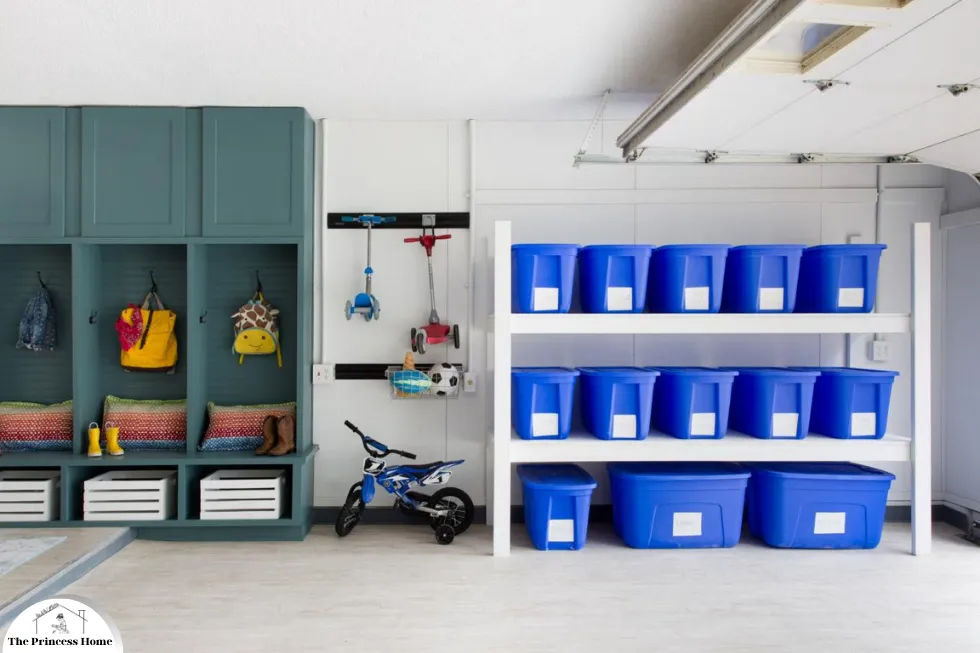
4.Invest in Storage Solutions:
Effective storage solutions are key to maintaining an organized space. Invest in storage bins, shelves, baskets, and other organizational tools to help keep items neatly stored and easily accessible. Investing in storage solutions is indeed essential for maintaining an organized and clutter-free space. investing in storage solutions is crucial for maintaining an organized and clutter-free space.
Here’s how you can make the most of storage solutions:
1.Assess Your Needs:
Take stock of the items you need to store and the available space in your home. Identify areas that could benefit from additional storage solutions, such as closets, cabinets, or underutilized corners.
2.Choose the Right Solutions:
Select storage containers, shelves, bins, and baskets that are suitable for the items you need to store. Consider factors such as size, material, and design to ensure they meet your needs and complement your space.
3.Maximize Vertical Space:
Utilize vertical space by installing shelves or storage racks on walls to free up floor space and maximize storage capacity. This is particularly useful in smaller spaces where every inch counts.
4.Use Clear Containers:
Opt for clear storage containers whenever possible to easily identify the contents without having to open them. This is especially helpful for items stored in closets, pantries, or other areas where visibility is limited.
5.Label Everything:
Labeling storage containers, shelves, and drawers can help you quickly locate items and maintain organization. Use labels or tags that are easy to read and update as needed when the contents change.
6.Group Similar Items Together:
Keep similar items together to streamline organization and make it easier to find what you need. For example, store all cleaning supplies in one area and kitchen gadgets in another.
7.Regular Maintenance:
Schedule regular maintenance sessions to declutter and reorganize storage areas. Take this opportunity to assess whether your current storage solutions are still working effectively and make any necessary adjustments.
8.Adapt as Needed:
Be flexible and willing to adapt your storage solutions as your needs change over time. You may need to reconfigure shelves, add or remove storage containers, or invest in additional solutions as your belongings evolve.
By investing in effective storage solutions and implementing organization strategies, you can create a tidy and functional space that enhances your daily life.
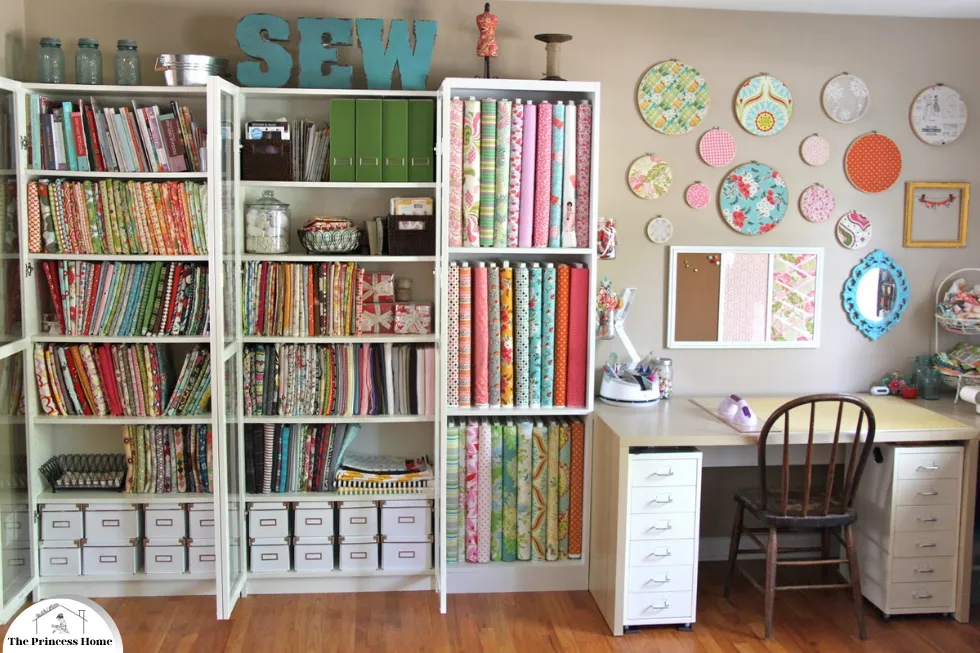
5.Create Designated Zones:
Designate specific areas for different activities or items within your space. Whether it’s a homework station, a crafting corner, or a filing system, having designated zones will help prevent clutter and confusion. Creating designated zones within your space is an excellent strategy for maintaining organization and efficiency.
Here’s how you can create designated zones to suit your needs:
1.Assess Your Space: Take a look at the layout of your home or workspace and identify areas that can be dedicated to specific activities or items. Consider factors such as available space, natural lighting, and proximity to utilities or supplies.
2.Identify Activities or Items: Determine the activities or items that you want to create designated zones for. This could include work or study areas, hobbies or crafts, storage for specific items, or functional zones like a reading nook or relaxation area.
3.Plan Layout and Organization: Once you’ve identified the activities or items, plan out the layout and organization of each designated zone. Consider the flow of the space, accessibility of supplies or tools, and any specific storage needs for each activity or item.
4.Allocate Space: Assign specific areas within your space to each designated zone based on your layout and organization plan. Use furniture, shelving, or room dividers to delineate different zones and create a sense of separation between them.
5.Personalize Each Zone: Tailor each designated zone to suit the activities or items it’s intended for. Customize the decor, furniture, and storage solutions to reflect the purpose of each zone and make it both functional and inviting.
6.Establish Boundaries: Clearly define the boundaries of each designated zone to prevent overlap and confusion. Use visual cues such as rugs, lighting, or wall decorations to demarcate the boundaries of each zone and reinforce their purpose.
7.Maintain Organization: Regularly declutter and organize each designated zone to keep it tidy and functional. Encourage household members or coworkers to respect the boundaries of each zone and return items to their designated locations after use.
By creating designated zones within your space, you can optimize organization, increase productivity, and enhance the overall functionality and enjoyment of your environment.

6.Establish Daily Habits:
Incorporate small cleaning tasks into your daily routine to prevent messes from piling up. Spend a few minutes each day tidying up surfaces, putting away items, and doing light cleaning. Establishing daily cleaning habits is an effective way to maintain a tidy and organized space without feeling overwhelmed.
How you can incorporate small cleaning tasks into your daily routine:
1.Set Aside Time:
Allocate a specific time each day for cleaning tasks, such as right after breakfast or before bed. Consistency is key to forming habits, so choose a time that works best for you and stick to it.
2.Create a Checklist:
Make a list of daily cleaning tasks that need to be completed, such as wiping down countertops, clearing clutter, and sweeping or vacuuming high-traffic areas. Having a checklist can help you stay focused and ensure that nothing gets overlooked.
3.Start Small:
Break down cleaning tasks into smaller, more manageable steps to make them less daunting. Spend just a few minutes each day tackling one or two tasks, rather than trying to clean the entire house all at once.
4.Focus on High-Traffic Areas:
Prioritize cleaning high-traffic areas of your home, such as the kitchen, living room, and bathroom. These areas tend to accumulate messes more quickly, so giving them a little attention each day can help prevent buildup.
5.Use Quick Cleaning Methods:
Opt for quick and efficient cleaning methods that don’t require a lot of time or effort. For example, use disinfectant wipes to quickly clean surfaces, or invest in a handheld vacuum for spot cleaning.
6.Involve the Whole Family:
Encourage household members to pitch in with daily cleaning tasks to lighten the load and instill a sense of responsibility. Assign age-appropriate tasks to children to help them develop good cleaning habits from a young age.
7.Reward Yourself:
Celebrate your accomplishments and progress with small rewards or treats to reinforce your daily cleaning habits. Whether it’s enjoying a cup of tea after completing your tasks or treating yourself to a movie night, find ways to make cleaning feel rewarding.
By incorporating small cleaning tasks into your daily routine, you can keep your space looking tidy and inviting with minimal effort. Plus, you’ll enjoy the satisfaction of maintaining a clean and organized environment on a consistent basis.

7.Set Aside Time for Deep Cleaning:
While daily maintenance is important, don’t forget to schedule regular deep cleaning sessions. Set aside time each week or month to tackle more intensive cleaning tasks like vacuuming, mopping, and dusting. .incorporating regular deep cleaning sessions into your cleaning routine is essential for maintaining a clean and healthy living environment.
How you can effectively set aside time for deep cleaning:
1.Schedule Deep Cleaning Sessions:
Block out specific times in your calendar for deep cleaning sessions, whether it’s once a week, every two weeks, or once a month. Consistency is key, so choose a schedule that works for you and stick to it.
2.Create a Deep Cleaning Checklist:
Make a list of deep cleaning tasks that need to be completed during each session. This may include tasks such as vacuuming and mopping floors, dusting furniture and fixtures, cleaning windows and mirrors, and deep cleaning appliances and surfaces.
3.Prioritize Tasks:
Prioritize deep cleaning tasks based on the areas of your home that need the most attention. Focus on high-traffic areas, such as the kitchen and bathroom, as well as areas that are easily overlooked during daily cleaning routines.
4.Gather Supplies:
Ensure you have all the necessary cleaning supplies and equipment on hand before starting your deep cleaning session. This may include cleaning solutions, brushes, sponges, microfiber cloths, and a vacuum cleaner with attachments.
5.Divide and Conquer:
Break down the deep cleaning tasks into smaller, more manageable chunks to prevent overwhelm. Focus on one area or task at a time, such as cleaning one room or tackling a specific cleaning task, before moving on to the next.
6.Enlist Help if Needed:
If deep cleaning your entire home feels like a daunting task, don’t hesitate to enlist the help of family members or housemates. Assign specific tasks to each person to divide the workload and make the process more efficient.
7.Reward Yourself:
Celebrate your accomplishments after completing a deep cleaning session by treating yourself to something enjoyable, whether it’s a relaxing bath, a favorite meal, or some well-deserved downtime.
By setting aside time for regular deep cleaning sessions and following a structured approach, you can ensure that your home remains clean, fresh, and inviting for you and your family to enjoy.
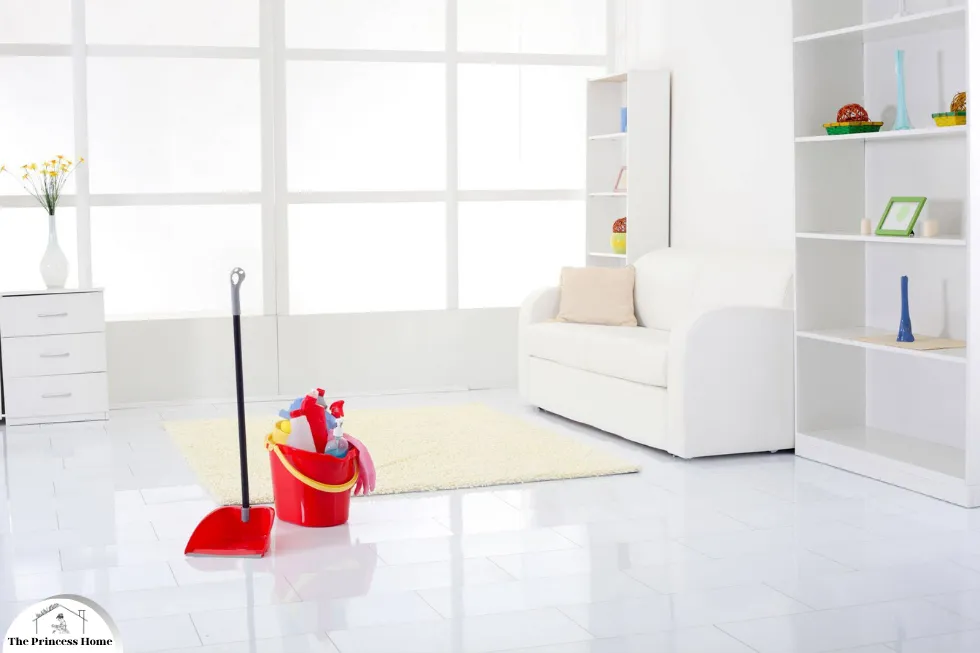
8.Prioritize High-Traffic Areas:
Focus your cleaning efforts on high-traffic areas like entryways, living rooms, and kitchens. These areas tend to accumulate the most dirt and clutter, so keeping them clean will have a big impact on the overall feel of your space. Prioritizing high-traffic areas in your cleaning routine is a smart strategy for maintaining a clean and welcoming home.
Here’s how you can effectively focus your cleaning efforts :
1.Identify High-Traffic Areas: Take note of the areas in your home that receive the most foot traffic and activity. Common high-traffic areas include entryways, living rooms, kitchens, hallways, and bathrooms.
2.Establish a Cleaning Routine: Incorporate regular cleaning of high-traffic areas into your daily or weekly cleaning routine. Dedicate specific time slots to tackle these areas to ensure they receive the attention they need to stay clean and tidy.
3.Focus on Surface Cleaning: Pay close attention to surfaces in high-traffic areas, such as countertops, tables, and floors. Wipe down surfaces regularly to remove dust, dirt, and spills, and vacuum or sweep floors to keep them free of debris.
4.Declutter Frequently: High-traffic areas are prone to accumulating clutter, so make decluttering a regular part of your cleaning routine. Take a few minutes each day to tidy up and put away items that have been left out of place.
5.Address Stains and Spills Promptly: Accidents happen, especially in high-traffic areas like the kitchen and living room. Be proactive about addressing stains and spills as soon as they occur to prevent them from becoming more difficult to clean later on.
6.Use Entryway Solutions: Minimize the amount of dirt and debris that gets tracked into your home by using entryway solutions such as doormats, shoe racks, and entryway benches with storage. Encourage family members and guests to remove their shoes upon entering to help keep floors clean.
7.Rotate Deep Cleaning: While it’s important to maintain regular cleaning of high-traffic areas, don’t forget to schedule periodic deep cleaning sessions to tackle more intensive tasks such as vacuuming upholstery, cleaning baseboards, and washing windows.
By prioritizing high-traffic areas in your cleaning routine, you can effectively maintain a clean, inviting, and comfortable living environment for you and your family to enjoy.

9.Multi-Purpose Cleaning Products:
Simplify your cleaning routine by using multi-purpose cleaning products that can tackle a variety of surfaces and messes. Look for eco-friendly options to minimize your environmental footprint. Using multi-purpose cleaning products is a fantastic way to streamline your cleaning routine and reduce clutter under your sink.
Here’s how you can effectively incorporate multi-purpose cleaners.
1.Choose Eco-Friendly Options: Look for multi-purpose cleaning products that are environmentally friendly and free from harsh chemicals. Many eco-friendly cleaners are made from natural ingredients and are biodegradable, making them safer for both your family and the planet.
2.Read Labels Carefully: When selecting multi-purpose cleaners, read the labels carefully to ensure they are suitable for the surfaces you intend to clean. Some cleaners may be formulated for specific materials like glass, countertops, or floors, while others are more versatile and can be used on multiple surfaces.
3.Opt for Concentrated Formulas: Concentrated cleaning formulas are not only more environmentally friendly due to reduced packaging but also more economical in the long run. Dilute concentrated cleaners according to the manufacturer’s instructions to create effective cleaning solutions.
4.Use Reusable Spray Bottles: Instead of purchasing single-use spray bottles for each cleaning product, invest in a few high-quality reusable spray bottles. Label each bottle with the type of cleaner it contains to avoid confusion and mix-ups.
5.Test Compatibility: Before using a multi-purpose cleaner on a new surface, test it in an inconspicuous area to ensure compatibility and prevent damage. This is especially important for sensitive surfaces like marble or hardwood floors.
6.Combine with Microfiber Cloths: Pairing multi-purpose cleaners with microfiber cloths is an effective way to clean surfaces without relying on disposable wipes or paper towels. Microfiber cloths are reusable, highly absorbent, and excellent at trapping dirt and dust.
7.Rotate Specialty Cleaners Sparingly: While multi-purpose cleaners are versatile, there may be times when you need a specialized cleaner for tough stains or specific surfaces. Rotate the use of specialty cleaners sparingly to avoid unnecessary clutter and environmental impact.
By incorporating eco-friendly multi-purpose cleaners into your cleaning routine, you can simplify your cleaning arsenal, minimize your environmental footprint, and achieve sparkling clean surfaces throughout your home.

10. Paper Management System:
Paper clutter can quickly overwhelm a space. Establish a paper management system that includes categories for filing, shredding, and recycling to keep paper clutter at bay. Establishing a paper management system is crucial for keeping paper clutter under control and maintaining an organized space.
Here’s how you can create an effective paper management system:
1.Designate Paper Zones:
Allocate specific areas in your home or office for managing different types of paper, such as incoming mail, important documents, and reference materials. This could include a desk drawer, filing cabinet, or dedicated desktop organizer.
2.Sort Incoming Mail:
Designate a central location, such as a mail organizer or inbox, for sorting incoming mail as soon as it enters your home. Sort mail into categories such as bills to pay, documents to file, items to review, and junk mail to recycle or shred.
3.Establish Filing Categories:
Create a filing system with clearly labeled folders or containers for organizing important documents and paperwork. Common categories include financial records, medical documents, household documents, and personal records. Be sure to regularly review and purge outdated or unnecessary documents to prevent accumulation.
4.Implement a Shredding System:
Set up a shredding station or invest in a paper shredder to securely dispose of sensitive documents and paperwork containing personal or confidential information. Shred documents that contain sensitive information before recycling or disposing of them to protect your privacy.
5.Schedule Regular Maintenance:
Set aside time on a regular basis to review and process incoming mail, file important documents, shred outdated paperwork, and declutter paper clutter. Establishing a routine for paper management can help prevent accumulation and keep your space organized.
6.Go Digital:
Whenever possible, opt for digital versions of documents and paperwork to reduce paper clutter. Scan important documents and save them electronically to a secure digital storage system or cloud-based service. This not only saves space but also makes documents easily accessible and searchable.
7.Reduce Unnecessary Paper:
Take steps to reduce the amount of unnecessary paper entering your home or office. Opt out of paper statements and bills where possible, unsubscribe from junk mail and catalogs, and use electronic communication and billing methods whenever feasible.
By establishing a paper management system with designated zones for sorting, filing, shredding, and recycling, you can effectively manage paper clutter and maintain an organized space. Consistency and regular maintenance are key to keeping your paper management system running smoothly over time.
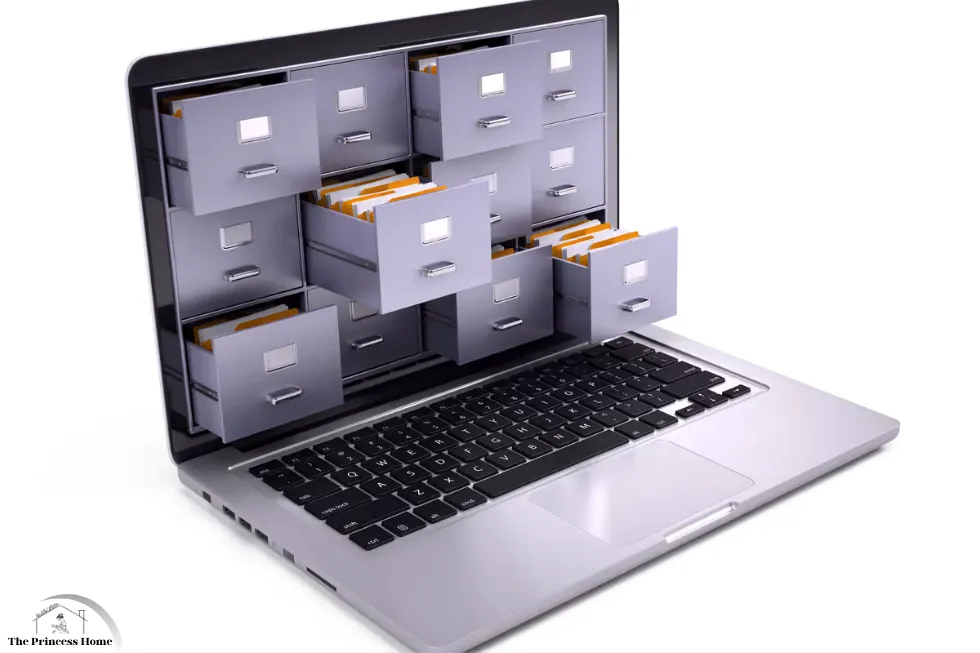
11. Digital Decluttering
In today’s digital age, decluttering extends beyond physical spaces to include digital environments such as computers, smartphones, and email inboxes. Digital clutter, including old files, unused apps, and overflowing email inboxes, can be just as overwhelming and distracting as physical clutter. Schedule regular digital decluttering sessions to organize files, delete unnecessary apps, and unsubscribe from irrelevant email lists. Utilize digital tools such as file management software and productivity apps to streamline your digital workflow and enhance efficiency.
Here’s how you can effectively manage digital clutter.
1.Organize Digital Files:
Start by organizing your digital files into logical folders and subfolders on your computer or cloud storage service. Create a clear and consistent file structure that makes it easy to find and access documents, photos, and other files when needed.
2.Declutter Email Inbox:
Regularly review and declutter your email inbox to keep it organized and manageable. Delete or archive old emails, unsubscribe from unwanted mailing lists, and create folders or labels to categorize and prioritize incoming emails.
3.Streamline Digital Apps:
Evaluate the digital apps and tools you use regularly and declutter any that are no longer useful or necessary. Delete unused apps from your devices and organize remaining apps into folders or categories for easier access.
4.Backup and Sync Data:
Ensure that your digital files and data are securely backed up and synced across all of your devices. Use cloud storage services or external hard drives to backup important files regularly to prevent data loss and ensure accessibility.
5.Manage Digital Photos and Media:
Organize and declutter digital photos and media files by deleting duplicates, blurry images, and unnecessary files. Use photo management software or apps to organize photos into albums and tag them for easy searching.
6.Limit Notifications:
Reduce digital clutter and distractions by limiting notifications from apps, email, and social media platforms. Disable unnecessary notifications or adjust settings to receive only the most important notifications.
7.Establish Digital Boundaries:
Set boundaries for your digital usage to prevent digital clutter from accumulating in the first place. Establish designated times for checking email and social media, and use digital tools and apps intentionally to minimize distractions.
8.Regular Maintenance:
Schedule regular maintenance sessions to review and declutter your digital space. Set aside time each week or month to tidy up digital files, emails, and apps to prevent clutter from building up over time.
By taking proactive steps to organize and declutter your digital space, you can reduce digital overwhelm, increase productivity, and create a more streamlined and efficient digital workflow.
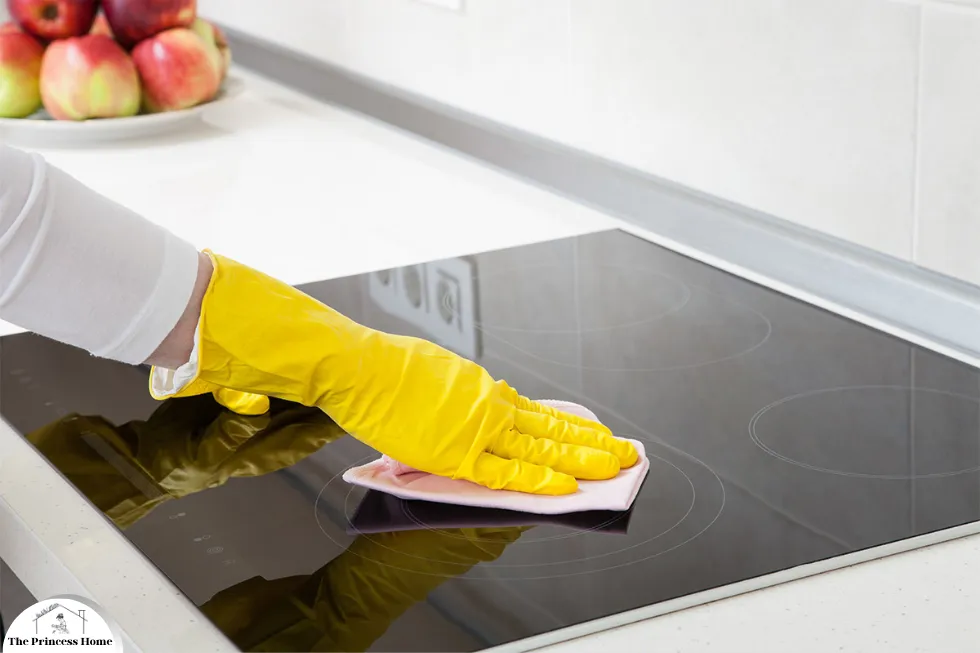
12.Clean as You Cook:
If you tend to make a mess while cooking, adopt the habit of cleaning as you go. Wash dishes, wipe down countertops, and put away ingredients as you prepare your meals to prevent a big mess from accumulating. Cleaning as you cook is a fantastic habit to adopt that can significantly reduce the amount of cleanup required after meal preparation.
Here’s how you can effectively clean as you cook:
1.Prepare Your Workspace:
Before you start cooking, ensure that your kitchen workspace is clean and organized. Clear off countertops, empty the sink, and gather all the necessary ingredients and utensils.
2.Clean as You Prep:
As you prepare ingredients for your recipe, wash and chop vegetables, measure out spices, and organize other ingredients. Immediately wash any dishes, cutting boards, or utensils that you no longer need to keep your workspace tidy.
3.Use Multiple Bowls and Utensils:
When cooking multiple dishes or components of a meal, use separate bowls, pots, and utensils for each to minimize cross-contamination and make cleanup easier. Rinse and reuse bowls and utensils as needed to keep clutter to a minimum.
4.Wipe Down Surfaces:
Take a moment to wipe down countertops, stovetops, and other surfaces as you cook to prevent spills and splatters from drying and becoming more difficult to clean later on. Keep a damp cloth or sponge nearby for quick cleanup.
5.Soak and Pre-Treat:
If you encounter stubborn stains or spills while cooking, quickly soak or pre-treat them to prevent them from setting. This will make them easier to clean later on and reduce the amount of scrubbing required.
6.Dispose of Waste:
As you cook, dispose of food scraps, packaging, and other waste in a designated trash or compost bin. Keeping your workspace clear of clutter will make it easier to move around and clean up as you go.
7.Clean as You Wait:
Take advantage of downtime while waiting for food to cook or simmer by tackling small cleaning tasks. Wash a few dishes, wipe down a countertop, or sweep the floor to make the most of your time.
8.Finish with a Final Cleanup:
Once your meal is prepared and served, take a few minutes to do a final cleanup of your workspace. Wash any remaining dishes, wipe down surfaces, and put away ingredients to leave your kitchen clean and tidy.
By incorporating the habit of cleaning as you cook into your meal preparation routine, you can minimize the time and effort required for cleanup afterward and enjoy a more organized and efficient cooking experience.

13.Get the Whole Family Involved:
Cleaning and organizing shouldn’t fall solely on one person’s shoulders. Get the whole family involved by assigning age-appropriate tasks and establishing a chore chart to keep everyone accountable. Getting the whole family involved in cleaning and organizing is a great way to distribute the workload and teach valuable life skills.
Here’s how you can effectively get everyone on board:
1.Assign Age-Appropriate Tasks:
Consider the abilities and interests of each family member when assigning tasks. Younger children can help with simple tasks like putting away toys, sorting laundry, or dusting, while older children can take on more responsibility with tasks like vacuuming, washing dishes, or cleaning bathrooms.
2.Establish a Chore Chart:
Create a chore chart or family cleaning schedule to outline each person’s responsibilities and hold everyone accountable. Include a mix of daily, weekly, and monthly tasks, and rotate assignments regularly to prevent boredom and ensure fairness.
3.Set Clear Expectations:
Communicate clear expectations for each task, including how it should be done and when it needs to be completed. Provide guidance and support as needed, especially for younger children or those who are learning new skills.
4.Make It Fun:
Turn cleaning into a positive and enjoyable experience by making it fun for the whole family. Play upbeat music, set a timer for cleaning challenges, or offer rewards or incentives for completing tasks. Consider turning cleaning into a game or competition to keep everyone engaged and motivated.
5.Lead by Example:
Be a role model for your family by demonstrating a positive attitude towards cleaning and organizing. Show enthusiasm for tackling tasks together as a family and praise everyone for their efforts and contributions.
6.Work Together as a Team:
Encourage teamwork and cooperation by working together to tackle larger cleaning projects or organizing tasks. Assign specific roles to each family member and emphasize the importance of supporting one another to achieve common goals.
7.Celebrate Success:
Celebrate achievements and milestones as a family to recognize everyone’s hard work and dedication. Whether it’s a pizza night, movie marathon, or family outing, find ways to celebrate your collective efforts and accomplishments.
8.Hold Regular Family Meetings:
Schedule regular family meetings to discuss cleaning routines, address any challenges or concerns, and solicit feedback from family members. Encourage open communication and collaboration to ensure that everyone feels valued and heard.
By involving the whole family in cleaning and organizing tasks, you not only lighten the load for everyone involved but also foster a sense of teamwork, responsibility, and pride in maintaining a clean and organized home.
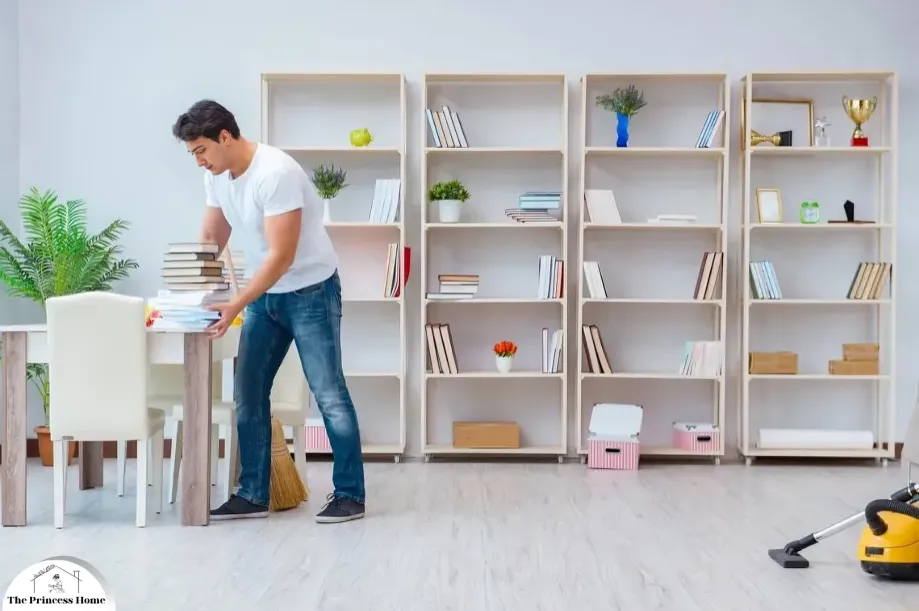
14.Maximize Vertical Space:
When it comes to storage, don’t forget to utilize vertical space. Install shelves, hooks, and organizers on walls to maximize storage space and keep clutter off the floor. Maximizing vertical space is an excellent strategy for increasing storage capacity and keeping your living area organized.
Here’s how you can effectively utilize vertical space:
1.Install Wall Shelves: Install shelves on walls to create additional storage space for books, decorative items, or everyday essentials. Choose floating shelves for a sleek and minimalist look, or opt for wall-mounted shelves with brackets for added support.
2.Use Over-the-Door Organizers: Over-the-door organizers are perfect for maximizing vertical space in closets, bathrooms, or bedrooms. Use them to store shoes, accessories, cleaning supplies, or toiletries without taking up valuable floor space.
3.Hang Hooks and Pegboards: Install hooks or pegboards on walls to hang coats, hats, bags, keys, or kitchen utensils. This keeps frequently used items easily accessible while freeing up drawer and countertop space.
4.Mount Wall-Mounted Cabinets: Wall-mounted cabinets are ideal for storing items in kitchens, bathrooms, or home offices. Install them above countertops or desks to keep frequently used items within reach without cluttering valuable workspace.
5.Utilize Tall Furniture: Choose tall furniture pieces such as bookcases, armoires, or cabinets to maximize vertical storage space. Look for pieces with adjustable shelves or built-in organizers to customize storage to your needs.
6.Invest in Vertical Organizers: Use vertical organizers such as baskets, bins, or stackable drawers to maximize storage space in closets, pantries, or under sink areas. These organizers make it easy to group and access items while keeping them neatly contained.
7.Create a Gallery Wall: Display artwork, photos, or decorative items on a gallery wall to add visual interest while maximizing vertical space. Arrange frames or artwork in a grid pattern or asymmetrical layout to suit your style.
8.Think Upward in Small Spaces: In small living spaces, such as studio apartments or tiny homes, vertical storage is essential for maximizing square footage. Look for innovative solutions such as loft beds with built-in storage or wall-mounted folding desks to make the most of limited space.
By utilizing vertical space effectively, you can increase storage capacity, keep clutter at bay, and create a more organized and functional living environment. Whether you’re dealing with a small space or simply looking to optimize storage in your home, maximizing vertical space is a smart and practical solution.

15.Rotate Seasonal Items:
To prevent overcrowding, consider rotating seasonal items in and out of storage. Store off-season clothing, decorations, and equipment in labeled bins or containers to free up space for items you use regularly. Rotating seasonal items is a smart approach to managing storage space effectively and keeping your living areas clutter-free.
Here’s how you can implement a seasonal rotation system:
1.Sort and Label:
Begin by sorting through your belongings and identifying items that are specific to certain seasons, such as clothing, decorations, or recreational equipment. Use labeled bins, containers, or storage bags to organize and store these items according to season.
2.Store Off-Season Items:
Pack away off-season items in designated storage areas, such as closets, attics, basements, or storage units. Make sure to label each container clearly with its contents and the season it corresponds to for easy identification.
3.Maximize Vertical Space:
Utilize vertical space in storage areas by stacking labeled bins or installing shelving units to maximize storage capacity. Keep frequently accessed items within easy reach and reserve higher shelves for less frequently used items.
4.Regularly Rotate Items:
Rotate seasonal items in and out of storage as the seasons change. At the beginning of each season, take inventory of stored items and swap out off-season items for those that are currently in use.
5.Inspect and Maintain:
Before storing seasonal items, inspect them for damage or wear and tear. Repair or clean items as needed to ensure they remain in good condition while in storage. Proper maintenance will prolong the lifespan of your belongings and ensure they’re ready to use when the season rolls around again.
6.Donate or Declutter:
Take the opportunity to declutter and donate items that you no longer need or use before storing them away for the season. This will help reduce clutter and make more space available for items you truly value and enjoy.
7.Plan Ahead:
Anticipate your seasonal storage needs and plan accordingly. Consider investing in durable, airtight storage containers to protect items from dust, moisture, and pests while in storage. Additionally, make a note of any items that may need to be replaced or replenished before the next season begins.
By implementing a seasonal rotation system and storing off-season items in labeled containers, you can maximize storage space, reduce clutter, and keep your living areas organized throughout the year.
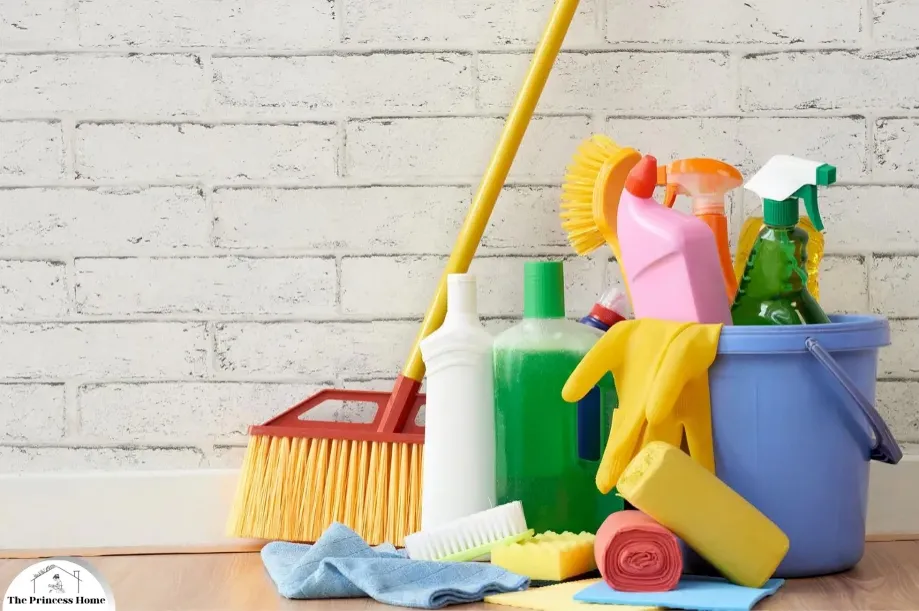
16.Invest in Quality Cleaning Tools:
Having the right cleaning tools can make all the difference in the effectiveness of your cleaning routine. Invest in quality brooms, mops, vacuum cleaners, and other tools to ensure you’re able to tackle any mess. Investing in quality cleaning tools is essential for maintaining a clean and hygienic living environment.
Here are some key cleaning tools to consider investing in:
1.Vacuum Cleaner:
A good quality vacuum cleaner is essential for keeping floors clean and free of dust, dirt, and debris. Choose a vacuum cleaner with strong suction power, versatile attachments, and HEPA filtration for optimal performance.
2.Broom and Dustpan:
A sturdy broom and dustpan set is essential for sweeping up dirt, crumbs, and debris from hard floors. Look for a broom with stiff bristles and a dustpan with a rubber edge to efficiently collect and dispose of dirt.
3.Mop and Bucket:
For cleaning hard floors, invest in a quality mop and bucket set. Choose a mop with a removable, machine-washable head and a bucket with a wringer to easily control the amount of water used during mopping.
4.Microfiber Cloths:
Microfiber cloths are versatile cleaning tools that are highly effective at trapping dust, dirt, and bacteria without the need for harsh chemicals. Invest in a variety of microfiber cloths for dusting, wiping surfaces, and cleaning windows and mirrors.
5.Scrub Brushes:
Scrub brushes are useful for tackling tough stains, grime, and buildup on surfaces such as tile, grout, and countertops. Look for scrub brushes with ergonomic handles and stiff bristles for effective scrubbing power.
6.Sponges and Scrubbers:
Stock up on durable sponges and scrubbers for cleaning dishes, countertops, and other surfaces. Choose sponges with abrasive scrubbing pads for tackling stubborn stains and baked-on food.
7.Cleaning Caddy or Tote:
Keep your cleaning tools organized and easily accessible with a cleaning caddy or tote. Choose a caddy with compartments or pockets to hold cleaning supplies, brushes, and cloths while you clean.
8.Steam Cleaner:
For deep cleaning and sanitizing hard surfaces, consider investing in a steam cleaner. Steam cleaners use hot steam to kill bacteria and germs without the need for harsh chemicals, making them ideal for allergy sufferers and environmentally conscious individuals.
By investing in quality cleaning tools, you can ensure that your cleaning routine is efficient, effective, and thorough. Quality tools will also last longer and provide better results compared to cheaper alternatives, making them a worthwhile investment in the long run.

17.Practice Mindful Consumption:
Before making a purchase, ask yourself if the item is truly necessary and if it will add value to your life. Practicing mindful consumption will help prevent unnecessary clutter from entering your space. Practicing mindful consumption is an excellent way to reduce clutter and make more intentional choices about the items you bring into your home.
Here are some tips for incorporating mindful consumption into your shopping habits:
1.Evaluate Need vs. Want: Before making a purchase, take a moment to consider whether the item is something you truly need or simply something you want. Ask yourself if the item will add value to your life and if it aligns with your priorities and values.
2.Consider Quality Over Quantity: Instead of opting for cheap, disposable items, prioritize quality over quantity. Invest in well-made, durable products that will last longer and provide more value over time. Quality items may have a higher upfront cost, but they often offer better performance and longevity.
3.Do Your Research: Before making a purchase, research the product to learn more about its features, materials, and reviews from other consumers. Look for products that are ethically sourced, sustainably produced, and environmentally friendly whenever possible.
4.Practice Delayed Gratification: Instead of making impulse purchases, practice delayed gratification by waiting before buying. Give yourself time to consider whether the item is something you truly need and whether you’ll still want it after a cooling-off period.
5.Shop with Intention: When shopping, have a clear idea of what you’re looking for and stick to your shopping list. Avoid browsing aimlessly or succumbing to sales and marketing tactics that encourage impulse buying. Focus on purchasing items that serve a specific purpose and fill a genuine need.
6.Avoid Overconsumption: Be mindful of consumer culture and the pressure to constantly buy new things. Challenge the idea that happiness and fulfillment come from material possessions, and instead focus on experiences, relationships, and personal growth.
7.Practice Gratitude: Cultivate a sense of gratitude for the things you already have rather than constantly seeking more. Take time to appreciate and care for the belongings you already own, and be mindful of the resources that went into producing them.
By practicing mindful consumption, you can reduce clutter, save money, and make more conscious choices about the items you bring into your home. Embracing a minimalist mindset and prioritizing quality over quantity can lead to a more fulfilling and intentional way of living.

18.Schedule Regular Maintenance Checks:
Don’t wait until things are falling apart to address maintenance issues. Schedule regular maintenance checks for appliances, HVAC systems, and other household equipment to ensure everything is running smoothly. Regular maintenance checks are essential for keeping your home in good condition and preventing costly repairs down the line.
Here’s how you can effectively schedule and conduct regular maintenance checks.
1.Create a Maintenance Schedule: Develop a maintenance schedule that outlines when various tasks need to be performed throughout the year. This could include monthly, quarterly, semi-annual, or annual checks depending on the type of equipment and manufacturer recommendations.
2.Keep a Maintenance Calendar: Use a calendar or digital scheduling tool to keep track of upcoming maintenance tasks and reminders. Set alerts or notifications to remind you when it’s time to perform routine checks or schedule service appointments.
3.Inspect Appliances: Regularly inspect appliances such as refrigerators, ovens, dishwashers, washing machines, and dryers for signs of wear, damage, or malfunction. Clean or replace filters, coils, and hoses as needed, and ensure that appliances are operating safely and efficiently.
4.Check HVAC Systems: Schedule regular maintenance checks for heating, ventilation, and air conditioning (HVAC) systems to ensure they’re operating at peak performance. Change air filters regularly, clean vents and ducts, and inspect for any signs of leaks, damage, or inefficiency.
5.Test Safety Devices: Test smoke detectors, carbon monoxide detectors, and fire extinguishers regularly to ensure they’re functioning properly. Replace batteries in smoke and carbon monoxide detectors at least once a year, and replace expired fire extinguishers as needed.
6.Inspect Plumbing and Electrical Systems: Check for leaks, drips, or other plumbing issues throughout your home, including faucets, toilets, and pipes. Inspect electrical outlets, switches, and wiring for signs of damage or wear, and schedule professional inspections if needed.
7.Inspect Roof and Gutters: Regularly inspect your roof for signs of damage, such as missing or damaged shingles, leaks, or debris buildup. Clean gutters and downspouts regularly to prevent clogs and water damage to your home’s exterior.
8.Perform Seasonal Checks: Adjust your maintenance schedule based on seasonal changes and specific needs. For example, schedule HVAC tune-ups before the start of the heating or cooling season, and prepare outdoor equipment and landscaping for winter weather.
9.Keep Records: Keep detailed records of maintenance checks, repairs, and service appointments for each appliance and system in your home. This will help you track maintenance history, identify trends or recurring issues, and ensure that no tasks are overlooked.
By scheduling regular maintenance checks and staying proactive about addressing any issues that arise, you can keep your home in good condition, extend the lifespan of your appliances and systems, and avoid unexpected repairs or breakdowns.

19.Create a Relaxing Environment:
In addition to keeping your space clean and organized, focus on creating a relaxing environment that promotes peace and tranquility. Incorporate elements like plants, soft lighting, and calming colors to enhance the atmosphere of your space. Creating a relaxing environment in your home is essential for promoting peace of mind and overall well-being.
Here are some tips for incorporating elements that contribute to a calming atmosphere:
1.Natural Elements: Introduce elements of nature into your space to create a sense of tranquility. Incorporate indoor plants, such as succulents or low-maintenance greenery, to bring a touch of greenery indoors and improve air quality.
2.Soft Lighting: Opt for soft, diffused lighting to create a warm and inviting ambiance. Use dimmer switches, table lamps, and candles to control the brightness of your lighting and create a cozy atmosphere, especially in the evenings.
3.Calming Colors: Choose soothing colors for your walls, furniture, and decor to create a calming visual environment. Soft neutrals, pastel hues, and earthy tones can evoke feelings of serenity and relaxation.
4.Comfortable Furniture: Invest in comfortable furniture pieces that invite relaxation and lounging. Choose plush sofas, armchairs, and throw pillows in soft fabrics to create cozy seating areas where you can unwind and relax.
5.Declutter and Simplify: Keep your space clutter-free and organized to create a sense of calm and order. Minimize visual clutter by simplifying your decor and keeping surfaces clear of unnecessary items.
6.Texture and Layers: Incorporate texture and layers into your decor to add depth and visual interest to your space. Use soft throws, area rugs, and textured fabrics to create a cozy and inviting atmosphere.
7.Scented Candles or Essential Oils: Use scented candles or essential oils to infuse your space with calming aromas. Choose fragrances like lavender, chamomile, or eucalyptus to promote relaxation and reduce stress.
8.Quiet Zones: Designate quiet zones in your home where you can escape from noise and distractions. Create a cozy reading nook, meditation corner, or relaxation space where you can unwind and recharge.
9.Personal Touches: Incorporate personal touches and meaningful decor items that bring you joy and comfort. Display photos, artwork, or mementos that evoke positive memories and emotions.
10.Mindful Practices: Practice mindfulness and relaxation techniques such as deep breathing, meditation, or gentle yoga to help you unwind and reduce stress in your daily life.
By incorporating these elements into your home environment, you can create a space that promotes relaxation, tranquility, and overall well-being. Take the time to prioritize self-care and create a sanctuary where you can escape from the stresses of daily life and find peace and rejuvenation.
Celebrate Your Progress:
Finally, don’t forget to celebrate your progress along the way. Maintaining a clean and organized space is an ongoing process, so take pride in the steps you’ve taken to create a space that feels welcoming and harmonious.
Conclusion:
Achieving and maintaining a clean and organized space requires commitment, consistency, and a willingness to let go of clutter. By implementing these 20 tips, you’ll be well on your way to creating a space that not only looks great but also supports your physical and mental well-being. So roll up your sleeves, put on some music, and get ready to transform your space into a clean and organized oasis.
Here are some frequently asked questions related to creating a minimalist lifestyle and their answers:
Q1: How often should I declutter my space?
A: The frequency of decluttering depends on your lifestyle and the size of your space. However, a good rule of thumb is to declutter at least once every few months to prevent clutter from accumulating.
Q2: What are some eco-friendly cleaning products I can use?
A: There are many eco-friendly cleaning products available on the market today, including ones made from natural ingredients like vinegar, baking soda, and essential oils. Look for products that are biodegradable, non-toxic, and free from harsh chemicals.
Q3: How can I motivate my family members to help with cleaning?
A: One way to motivate family members to help with cleaning is by making it a fun and collaborative activity. Consider turning cleaning sessions into a game or offering rewards for completing tasks. Additionally, clearly communicate expectations and the importance of everyone pitching in to maintain a clean and organized space.
Q4: What should I do with items I no longer need or use?
A: When decluttering, consider donating items that are still in good condition to local charities or thrift stores. You can also sell items online or host a garage sale to make some extra cash. For items that are no longer usable, recycle or dispose of them responsibly.
Q5: How can I keep my space clean and organized with a busy schedule?
A: Incorporating small cleaning tasks into your daily routine can help you stay on top of maintenance even with a busy schedule. Additionally, setting aside dedicated time for deep cleaning on a weekly or monthly basis can help prevent messes from getting out of control.
Q6: What are some tips for maintaining an organized digital space?
A: To maintain an organized digital space, regularly delete unnecessary files and emails, create folders to organize documents and photos, and use digital tools like calendar apps and task managers to stay organized. It’s also important to regularly back up important files to prevent data loss.
Q7: How can I make cleaning more enjoyable?
A: Making cleaning more enjoyable can be as simple as playing your favorite music or podcast while you clean, rewarding yourself with a treat or break after completing tasks, or involving family members or friends in cleaning sessions. Finding ways to make cleaning feel less like a chore and more like a positive activity can help motivate you to tackle tasks more enthusiastically.


